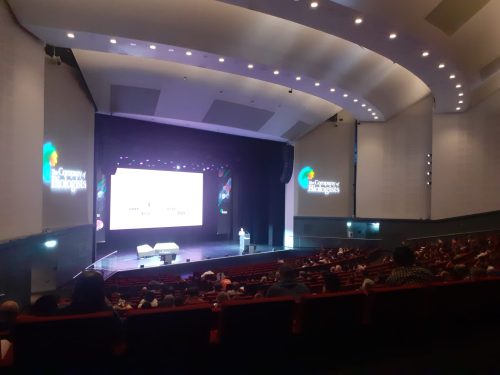Biologists@100: a blueprint for interdisciplinary meetings
Posted by Alexandra Bisia, on 12 May 2025
I was excited to be in Liverpool for the Biologists@100 meeting this past March. Not only is a meeting organised by The Company of Biologists always guaranteed to be friendly and exciting, this was also my first science-related activity back in the UK since I started a postdoc in Boston last November, so I was doubly happy to be there.

The most intriguing aspect of the meeting for me was the fact that it drew together an unusually broad range of scientists – this wasn’t your average BSDB/BSCB joint meeting! It was a celebration of the 100 years since the founding of The Company of Biologists and the 5 journals that are published under its umbrella. Accordingly, in addition to the cell and developmental biology track, there were three more included in the meeting, each in reality a mini symposium or satellite meeting: sensory perception (the Journal of Experimental Biology’s symposium), interdisciplinary approaches to combatting antimicrobial resistance (Disease Models & Mechanisms’ symposium), and experimental biology and impact: solutions to climate change and biodiversity loss, organised by the Society of Experimental Biology.


Bringing together many different groups of scientists that might not typically encounter each other at meetings and pooling resources has some practical perks: firstly, the meeting was held in the ACC, a big, comfortable, and supremely well-located venue right on the River Mersey. We were also very close to the Museum of Liverpool, where a welcome reception was held at the end of the first day, and St George’s Hall, where the conference’s gala dinner was held on the penultimate day of the conference.

However, what I appreciated most was getting to hear about many different types of science that I would not have normally expected to hear at a conference (and especially at the same conference!). The biodiversity and climate change plenary lectures by Jane Francis of the British Antarctic Survey, and Hans-Otto Pörtner from the Alfred Wegener Institute for Polar and Marine Research in Germany were on the one hand fascinating, and on the other hand greatly sobering. They highlighted the essential role every scientist (not just climate scientists) should play in disseminating accurate information about the climate catastrophe our planet is suffering, and what we should be doing to combat it.
The parallel session format of the conference meant that you could hop between tracks several times throughout the day and take in all the different types of science that converged at the meeting. For example, the sessions on sensory perception were very comprehensive, with talks on vision, light pollution, thermosensation, sound perception, magnetic and chemical senses. There were also talks and posters on insect behaviour and insect-plant parallel evolution – this is a very subjective opinion, but butterflies always make a conference more fun. I was also excited to attend one of the sessions on drug discovery and ‘omics. Talks ranged from large-scale efforts to combat the development of antimicrobial resistance, to systematically exploring the breadth of organic chemistry to discover new drugs. This might not be news to some readers, but I was not aware of the tendency of microbes that develop drug resistance to concomitantly become more sensitive to other classes of drugs. This is something that researchers are actively investigating in their efforts to combat antibiotic resistance.
There was also a handful of plant-themed posters and a couple of talks on plant biology. There I heard the best description of leaves from Dr Chris Whitewoods from the Sainsbury Lab in Cambridge: “kind of green, kind of flat, sort of pretty in the sunshine.” For someone who gave a talk on leaf air space development, it was hilarious to get such a fun, entry-level description of leaves. Speaking to the (relatively few) plant scientists that were present at the meeting, I wondered why there tend to be such few plant researchers at developmental and cell biology conferences. They shared with me that they tend to congregate at plant science conferences instead, so this is my personal plea to plant scientists and developmental biology conferences: please sign up for dev bio conferences / invite plant scientists to speak at them! It is so refreshing to hear about research in non-animal models (and this is coming from someone with a passion for animal development).
Overall, the Biologists@100 conference was a big success. It was fantastic to see old colleagues and former lecturers, meet new people and discuss potential collaborations, and above all be exposed to an unusually broad suite of scientific investigation. There is nothing quite as inspiring as sharing one’s excitement about research with others!


 (No Ratings Yet)
(No Ratings Yet)